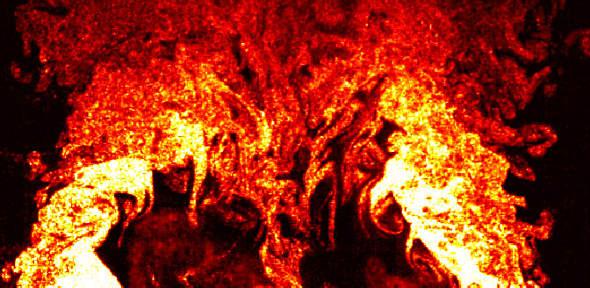
Nano-sized beauty, cutting-edge scientific advances and glimpses of remarkable humanitarian initiatives in distant parts of the world have all been captured in this year’s Engineering photo competition. The Department's annual contest invites anyone who works here - whether they are a Professor, student, or a member of the support staff - to submit a photograph connected with their day-to-day work.
The results represent an array of subjects, showcasing both the research and teaching that takes place within the Department and work undertaken by its staff in the field.
First prize in the 2010 competition went to Rob Gordon's Aircraft engine flame-out, which portrays a flame struggling for existence milliseconds before it was extinguished by freezing air.
The photograph was taken using two high-speed cameras working at 5000 frames per second, as part of research to improve the safety of aircraft engines. Freak weather can cause the flames inside an engine to go out, resulting in a subsequent loss of power. The research into the physics of flame extinction will help to reduce the likelihood of this rare, but potentially catastrophic, event.
The second prize was awarded to Ivor Day's photo, Turbine Wheel, which is one of hundreds taken while investigating the aerodynamics of a set of turbines. The blades were painted with brightly-coloured poster-paint mixed with light oil and then spun. The beautiful spectrum in the image was produced by examining the resulting flow lines on the blades using ultra-violet light.
Crystalline Entity by Rami R. M. Louca and Yun Thai Li gained third prize. The star-shaped crystal in the picture resembling a strange celestial body is actually zinc oxide on a supporting mesh made of amorphous carbon.
The photographers are researching material used in transistors, light emitting diodes and solar cells. Ultimately, this could mean the development of cheaper alternatives to the existing technology used in computers, mobile phones and solar-powered chargers, among other items.
Together, the 165 entries cover an extraordinary range of themes, revealing the breadth of research undertaken by engineers at Cambridge.
Microscopic images, some covering materials only nanometres in length and utterly invisible to the naked eye, include extreme close-ups of human bone cells, nano-tubes, electronic beams, concrete particles and even faecal pellets.
A photograph of pollen is aptly named Space Invaders due to its extra-terrestrial appearance when enlarged through the microscope's lens. Elsewhere, pictures capture bubbles at the moment of bursting and flickering methane flames, while a breathtaking image, The King Waves Goodbye, shows a bullet slicing through a playing card, decapitating a King of Diamonds with incredible precision.
Aside from the work in the laboratory, photographs taken during fieldwork pay tribute to the structural accomplishments of engineers, showing constructions including the Imerys China Clay Pit in Cornwall and the world's biggest hydraulic dam.
A solar car, named Endeavour, which was designed by the University's Eco-Racing Team, can be seen hurtling across the Australian outback during the 2009 Global Green Challenge.
Yet more images reveal how the work of engineers is helping to change lives, particularly in the developing world. Particularly moving is a series of photographs taken in Panama, Zambia and Kenya, which depicts the problems of inadequate drainage and water supply infrastructure in those countries.
The competition was sponsored by the electron microscopy division of Carl Zeiss, a field leader in optics, precision engineering and electronic visualisation. The panel of judges comprised the Cambridge researchers Roberto Cipolla (Professor of Information Engineering), Allan McRobie, Dame Professor Ann Dowling (Head of Department), and Philip Guildford (Director of Research).

